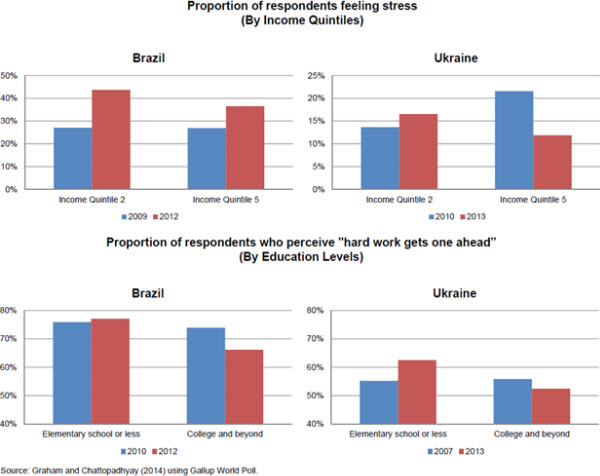As protests continue in countries around the world, we look back on some Brookings scholars’ research about such movements. Also, see what experts had to say at a recent event about the continuing protests in Hong Kong.
A DECADE OF PROTEST
In 2014, Carol Graham and Soumya Chattopadhyay were already saying the 2010s were “shaping up to be the decade of protest,” but not led by the poor. Instead, they found, protests were being led primarily by people who were middle-aged, middle income, and better-educated than average. Research shows that stress levels are highest in these groups, and those who are more educated are less likely to believe that hard work gets you ahead. “Left unaddressed,” they write, “festering public resentment can create as much economic and political turmoil as mismanaged macroeconomic policies can do – including in countries which are performing well economically.”

WOMENS’ RIGHTS AND HEADSCARVES IN IRAN
Obligatory modesty such as wearing of headscarves (hijab) has long been a politicized issue in many countries, from France banning any religious head coverings to protests over mandatory hijab in Iran. In a piece earlier this year, Suzanne Maloney and Eliora Katz told the story of Masih Alinejad, an Iranian journalist who fled the country in 2009, and then launched a protest movement against laws requiring hijab. They include data (below) from a February 2018 Iranian public opinion survey released by the Center for Strategic Studies in Iran. “Advocacy by Iranian human rights activists has re-opened additional professional opportunities for women,” Maloney and Katz wrote, “mitigated some of the most egregious discrimination in family laws, and inspired creative workarounds to official constraints.”

PROTESTERS AND THE MILITARY IN ALGERIA
Even after the resignation of Algerian President Abdelaziz Bouteflika on April 2, widespread protests continued demanding the fall of the entire regime. In a report, researchers detailed the relationship between protesters and the military, showing that while lower level military personnel tend to support the protests and their goals, higher level military officers are less supportive. However, moving forward, protesters are likely to come into conflict with military personnel of all ranks over the military’s political and economic privileges post-Bouteflika.


Commentary
Charts of the Week: Protests
November 22, 2019